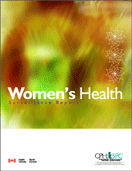
|
|


[Previous] [Table of Contents] [Next]
Violence Against Canadian Women
Marsha M. Cohen, MD and Heather Maclean, EdD (Centre for Research in Women's Health)
Health Issue
Exposure to violence as children or as adults places a woman at higher risk of poor
health outcomes, both physical and psychological. Abused women use more health
care services and have poorer social functioning than women who have not been
abused. Knowledge of the prevalence of violence against women, and of which women
are at risk, should assist in the planning of services for abuse prevention and treatment
of the health consequences of abuse. Data from the 1999 General Social Survey on
Victimization are presented to explore aspects of violence further.
Key Findings
- Overall, the highest rates of any partner violence were in Alberta (25.5%) and British Columbia (23%). The lowest rates were in Ontario (18.8%). Women aged 15-24 had the highest rates in all regions of Canada, compared with older women. Aboriginal women in Manitoba/Saskatchewan and Alberta had higher rates of violence (57.2% and 56.6% respectively) than non-Aboriginal women (20.6%).
- Overall, lower rates of partner-related violence were reported among women not born in Canada (18.4%) than among Canadian-born women (21.7%). Visible minority women reported lower rates of lifetime sexual assault (5.7%) than non-visible minority women (12.3%). Perceptions of violence may vary by ethnicity.
- Rates of any partner-related violence among women who had activity limitations were 35.6% in British Columbia as compared with 20.6% for those without activity limitations. The rate of lifetime sexual assault on women with activity limitations was 25.2% in British Columbia as compared with 14.5% for those with no limitations. Women with a spouse and children under age 25 were less likely than lone mothers to experience partner-related violence (16.5% versus 68.3% experienced violence respectively).
Data Gaps and Recommendations
The authors identified the following data gaps and made the following recommendations:
- More information is required concerning the prevalence of violence among Aboriginal women, immigrant and refugee women, women with disabilities, lesbian women, and pregnant women. It is also necessary to be able to correlate information on violence against women with health status data.
- National population-based surveys need to include items about both violence and health. Future surveys should have better questions to determine the health consequences of violence and related resource utilization.
- Further research is needed to identify the health care system's role in prevention, management, and rehabilitation as they relate to violence against women. Future programs and policies must be based on valid, reliable, and comprehensive empirical data.
- Coordination across the country in terms of violence studies and violence programs is needed. Dissemination of successful programs (based on evidence) to other jurisdictions would help reduce duplicate efforts and allow resources to be used directly for program implementation and research.
- More research is required on whether identifying violence and treatment would result in lower health care utilization and improved health outcomes.
- Much more needs to be known about the health effects of violence, its costs to the health care system, and the role of the health care system in reducing violence against women.
[Previous] [Table
of Contents] [Next]
|




